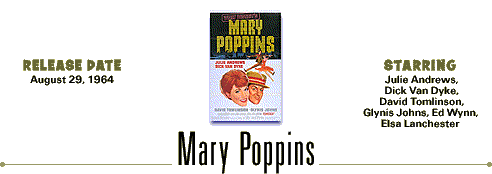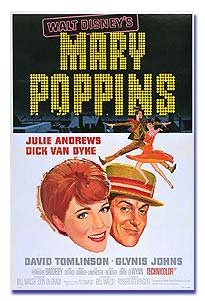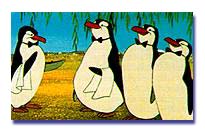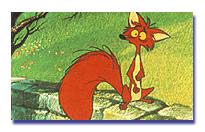 |
 |
 |
 magical English nanny, Mary Poppins, arrives at the
home of Mr. and Mrs. George Banks, facing the park at No. 17,
Cherry Tree Lane in London, to the delight of their young children,
Jane and Michael. The proper English father is too preoccupied with
his responsibility at the bank. The mother, an ardent suffragette,
is not really aware that their two children, left in the care of
one nanny after another, are unhappy and unable to communicate with
the parents they truly love. Mary Poppins has come to change all
this. She settles into the house and soon has everyone wrapped
around her little finger. Mary, along with her friend Bert and a
host of chimney sweeps, teaches the children how to have fun, and
in so doing makes the Banks household a happier place. By the time
she opens her umbrella and flies off on a beautiful spring evening,
the family is united together in the park, flying a kite. magical English nanny, Mary Poppins, arrives at the
home of Mr. and Mrs. George Banks, facing the park at No. 17,
Cherry Tree Lane in London, to the delight of their young children,
Jane and Michael. The proper English father is too preoccupied with
his responsibility at the bank. The mother, an ardent suffragette,
is not really aware that their two children, left in the care of
one nanny after another, are unhappy and unable to communicate with
the parents they truly love. Mary Poppins has come to change all
this. She settles into the house and soon has everyone wrapped
around her little finger. Mary, along with her friend Bert and a
host of chimney sweeps, teaches the children how to have fun, and
in so doing makes the Banks household a happier place. By the time
she opens her umbrella and flies off on a beautiful spring evening,
the family is united together in the park, flying a kite. |
|
 |

The special-effects work on "Mary Poppins" was the most challenging
the studio had ever known. Everything from the two-strip sodium
process and piano wire to bungee cords was used to create the
magical sequences. The work of the special-effects crew, as well as
all the production staff, was the culmination of years of Disney
innovation. In fact, only Marc Breaux and Dee Dee Wood, the
choreographers, and Irwin Kostal, the musical arranger, had to be
brought in from the outside; Disney staff members were called upon
for all of the other tasks. The entire film was shot on soundstages
at the Disney Studio in Burbank. A lavish premiere at Grauman's
Chinese Theater on August 27, 1964, began a fabulous box-office run
that made it Disney's most successful feature at that time. |
|
 |

Directed by Robert Stevenson. 139 min. This famed Disney masterwork
is indeed "practically perfect in every way," from its superb cast
to its lavish musical score and delightful songs provided by
Richard M. and Robert B. Sherman, which include such favorites as
"Spoonful of Sugar," "Feed the Birds," "Jolly Holiday," "Sister
Suffragette," "The Life I Lead," "Step in Time,"
"Supercalifragilisticexpialidocious," and "Let's Go Fly a Kite."
The Academy of Motion Picture Arts and Sciences agreed too, giving
it 13 nominations from which it won five Oscars® for Best
Actress (Julie Andrews), Best Song ("Chim Chim Cher-ee"), Best
Music Score (the Sherman Brothers), Best Film Editing (Cotton
Warburton), and Best Special Visual Effects (Peter Ellenshaw,
Eustace Lycett, and Hamilton Luske). There was also a special
Scientific award to Petro Vlahos, Wadsworth E. Pohl, and Ub Iwerks
for the creation and application of Color Traveling Matte Composite
Cinematography, which helped make possible the combination of live
action with animated actors in the film. P.L. Travers, author of
the popular books on which the film is based, continued writing new
adventures for Mary Poppins long after the film, and in the late
1980s worked with a Disney screenwriter on a film sequel that has
not yet materialized. Reissued theatrically in 1973 and 1980;
released on video in 1980 and kept available continuously. |
Learn more about Mary Poppins
at the Walt Disney Family Museum.
|
 |
 |
|
|
 |
 |
 |
|
|
 |
|
 |